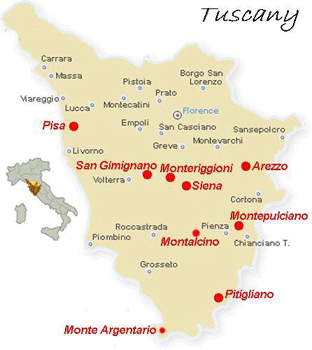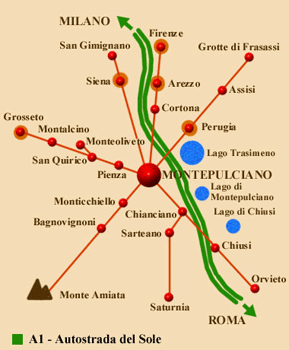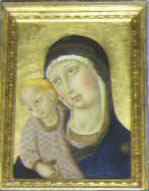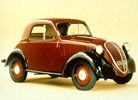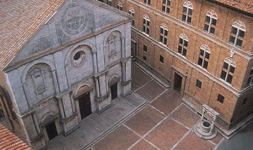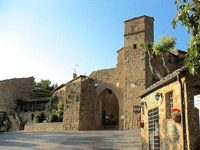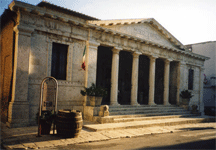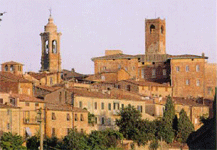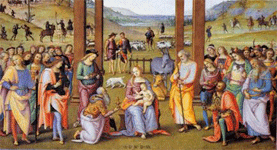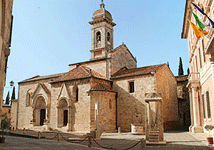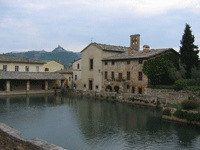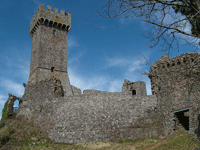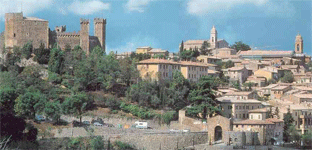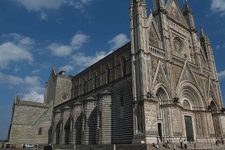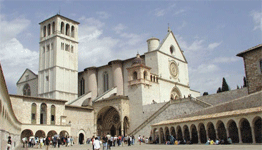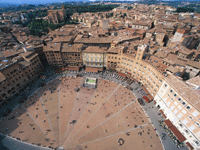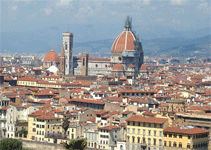Pienza (14 Km): Originally called Corsignano, it got its current name from Enea Silvio Piccolomini, the humanisr who was born here and who became Pope in 1458, unde the name of Pius II. Under the papacy of Pius II, as matter of fact, the small medieval village of Corsignano was deeply transformer into a papal residence, reflecting the renaissance stayle. Today, many places and the beautiful Cathedral of the Assumption are still remaining, of the original project done by Bernardo Gambarelli called the Rossellino, in 1459. Outside the city, the Romanic parish of Corsignano, remainder of the ancient glory of Pienza, is still standing.
Monticchiello (15Km): a few kilometers away from Pienza Monticchiello was built, a small village, already important during the Etruscan and Roman period, which might be dating back to the Gens romana Cloelia making the name Monticchiello derive, from the Latin Mons Cloelii. What is certain, is that Monticchiello is included in the list of castles wich, in 943 were left by Lamberto Aldobrandeschi to the Badia Amiatina. In 1156 it was donated to pope Adrian IV as feud by Count Paltonieri. The robust city wall and the quarterdeck tower above the hill. dating back to 1200, are still appearing intact and perfectly kept bestowing upon the village all the stern charactoeristics of medieval fortress. Important testimonial of this ancient splendor is, still today, the Curch of the Saint Leonard and Christopher, which is located in the heart of the village and which houses many frescos of the school of Siena dating back to the XIV and XV C. Extremely interesting at last, in the middle of July, is the possibility to see theater performances along the village streets acted by the well-known "poor theater" of Monticchiello.
Chiusi (19 Km): quite important Etruscan city, knew the most of its splendor under King Porsenna. There are numerous archeologica artifacts of Etruscan origin kept in the National Archeological Museum such as the beautiful necropolis wich is still surrounding the city.
Citta' della Pieve (28 Km): This small town had as one of its main features the characteristic aspect of its roads, large and windy for knights but also narrow and fragmentary for those who had to defend themselves on foot. Today it appears elegant and harmonious thanks to its Renaissance, Baroque, Rococo and Neoclassical taste. Characteristic is the pink color of the buildings, due to the utilization of lateritious, a peculiarity that binds Città della Pieve to the neighboring territory of Siena, very close also for cultural, economic and political reasons. In Citta' della Pieve you don't have to miss the Adoration of the Magi of the Perugino (1504), one of the last frescos of this great artist that is located in the Oratory of Santa Maria dei Bianchi
San Quirico d'Orcia (33 Km); small town that was already famous in the medieval times, due to its location on the Francigena route (route for pilgrimages that joined the English town of Canterbury with Rome, going through France and Switzerland) placed at 424 meters above sea level, on a hill which divides Valle d'Aso from Val d'Orcia. It stands out above all, for its still gorgeous and perfectly kept walls of medieval origin, but also because it houses the Collegiate Church, a church of the XII Century, a magnificent example of Romanic style with the most beautiful Lombard portal in the province of Siena.
Bagno Vignoni (38 Km): for those who like a relaxing bath in sulphurous water, we advise you to visit Bago Vignoni, a very old village, which was already a spa during the Etruscan and Roman Age and that has been prequented, among others, by important personalities such as Saint Catherine of Siena (1363), Lorenzo the Magnificent (1490) and Pope Pius II Piccolomini. In the middle of 1400 is when domus Piccolomini was built, it is a ville that Pope Pius Piccolomini had wanted, built by Rossellino (the current hotel "le terme") which is located on the main square of the village on the side of the beautiful and typical pool that has been forever gathering the beneficial waters that spur from different springs, from a depth of more that 1000 meters and a temperature of 52 C.
Radicofani (43 Km): For those who are longing for a panorama without any limits which is ranging from Amiata all the way to the Apennine mountain chain, from the Bolsena and Trasimeno lakes, to the soft glare of the Tyrrenian sea, must not miss the chance to visit Radicofani, a village that is located at the foot of a high volcanic cliff of basalitic stone that reaches up to 896 meters above sea level, crowned by the ruins of a mejestic fortress that for centuries ruled over the border pass between Tuscany and Lazio.
Montalcino (47Km): fascinating small town, surrounded by majestic walls and wide forest of helm-oaks from which its name might derive: Mons Ilcinus (Ilex is the Latin name of the helm-oak). Placed in a striking and dominating position, overlooking a countryside rich of olive trees and vineyards, Montalcino boast a large variety of high quality wines, among which the young Rosso di Montalcino, Moscatello, but above all the famous Brunello, one of the Italian red wines which are most appreciated all over the world (it's also one of the D.O.C. wines since 1966). Another important value is the extra-virgen olive oil production.
Abbey of Saint Antimo: at a distance of few kilometers from Montalcino it is surely worth to visit the beautiful abbey of Saint Antimo. It represents one of the most beautiful Romanic buildings throughout Italy, that by tradition, is had been built by Alexander the Great in 781, as an imperial vow to stop the plague which was destroying his army along the Francigena road. Still today, the monks perfor Gregorian chants in this abbey and celebrate Mass every Sunday.
Orvieto (68 Km): a surprising medieval town perched on a tufa rock hill. As well as its world famous cathedral, there are other very interesting monuments such as the double spyral well of San Patrizio. Later in the day, visit Bagnoregio (a small and charming medieval village put under the protection by Unesco for its extremely precarious stability).
Assisi (79 Km):the town of San Francesco with a number of fine gothic churches and a deeply mystic atmosphere.
You can finally organize a day trip to the beautiful cities of Siena (79 Km) and Florence (108 Km) |







